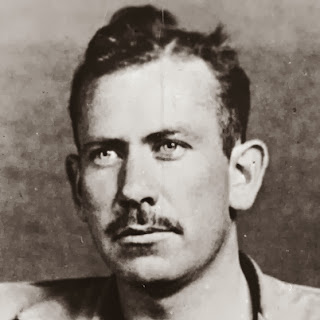John Ernst Steinbeck was born in 1902 in the Salinas Valley . He was the third of four children and the only boy. His family was close, the unity of the middle class living in a small community . The Salinas Valley later become the location of many of his books and stories. Both of his parents believed in exposing their children to culture and often traveled to San Francisco to attend the theater. They also had a wide variety of novels and literature available at home . At the age of nine, Steinbeck received a copy of Malory's Morte d' Arthur , which proved to be one of the biggest influences on his literary career. He attended Stanford University , where he majored in English , but never received a degree . He married three times , most recently to Elaine Scott in 1950 , which lasted until his death. He was the father of two children . He died in 1968 in New York, where he had lived from time to time since 1944. His ashes were buried in Salinas , California.
John Steinbeck Biography

After high school , Steinbeck occasionally worked in many different jobs , including a worker in a sugar factory in Salinas , a worker in the factories, and ranch hand . He also traveled throughout the Salinas Valley and studied marine life in Monterey Bay . He used many of his experiences for material in his later novels. He continued his writings along with dabbling employment of ordinary labor. In 1927 , she had her first article published in a professional smoker mate . It is said that he used the pseudonym John Stern, because he did not want to be associated with a magazine by that name (McCarthy 11). In 1929 , he published his first novel, Cup of Gold . However, he did not gain financial independence through writing until 1935 when he published Tortilla Flat, a novel that was initially rejected by several publishers . Tortilla Flat is a novel about the life of the peasants in Mexico , India and the Caucasus in people living mixed in Monterey . In 1937 , he published Of Mice and Men , one of the three novels that Steinbeck referred to as a "game - novella " . He wrote : " In short, Of Mice and Men was an attempt to write a novel that could be played from the lines, or a play that read " ( MacNicholas 272). This proved to be a successful work that was developed in the section of New York Music Theatre for 207 performances.
| Top | Steinbeck was a restless soul and traveled the world to appease their concerns. He used his travels as a basis for many novels and wrote many non-fiction magazines . Some of these magazines were Sea of Cortez (1942 ) , Travels with Charley in Search of America (1962) and A Russian Journal ( 1948). However, the most widely known books , the journey in 1937 with immigrants from around the country Oklahoma on Highway 66 to California, did not occur. He travel this way, but with his wife, Carol , not immigrants from Oklahoma. Carol says that this trip was purely for enjoyment and that Steinbeck did not even take notes. This trip is combined with a four week from Bakersfield to Needles in which he lived and worked with migrant depression allegedly began the inspiration for the acclaimed Grapes of Wrath ( 1939 ) for which he received a Pulitzer Prize.
During World War II , Steinbeck served as a correspondent for the New York Herald Tribune. He wrote several articles and two novels dealing with the war and were not considered among his best works . However, after his return from his travels during the war, wrote Cannery Row in just six weeks. This is said to be his only powerful novel of the time. Ironically, this is not war, but it is the residents of the row in Monterrey during the peaceful 1930.
Steinbeck continued his political involvement and the1950 of his writings turned to an intense and direct expression. He helped write speeches for the presidential campaigns of 1952 and 1954. In 1964 , he was appointed adviser to President Johnson. He was an active supporter of Viet Nam until he visited the devastated country. Then he encouraged Johnson to pull the troops out of the country .
John Steinbeck was a versatile writer. He has been described as a writer - the social protest , realist , naturalist, journalist and playwright. He has many strong themes running through his work. Most notable are the strengths of the family, the effects of the environment on man, and social protests . He experimented with many different writing styles and points of view. All these factors combine to explain why Steinbeck is still today a literary force. Your presence on the World Wide Web is great and he is the subject of many high school and college courses . Steinbeck had described his duty as a novelist in his acceptance of the Nobel Prize acceptance speech :
The ancient commission of the writer has not changed. He is charged with exposing our many grievous faults and failures, with the dredging up to the light our dark and dangerous dreams for the purpose of improvement. Furthermore, the writer is delegated to declare and to celebrate man's proven capacity for greatness of heart and spirit&emdash;for gallantry in defeat, for courage, compassion and love (MacNicholas 272).
 By
Published: 2013-12-19T04:27:00-08:00
John Steinbeck Biography
Publish John Steinbeck Biography di Bio Street, updated at: 4:27 AM. URL http://abalabalnyoba.blogspot.com/2013/12/john-steinbeck-biography.html.
By
Published: 2013-12-19T04:27:00-08:00
John Steinbeck Biography
Publish John Steinbeck Biography di Bio Street, updated at: 4:27 AM. URL http://abalabalnyoba.blogspot.com/2013/12/john-steinbeck-biography.html. Redaction Michele Brown

